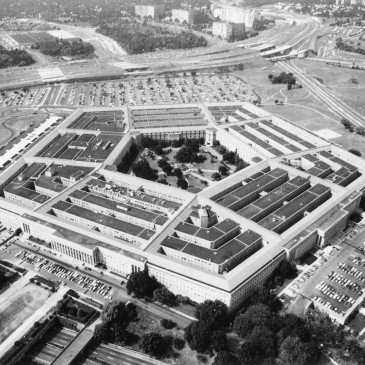FLIGHT-19, MILITARY UNIFICATION & NATIONAL SECURITY
Did the Navy Intentionally Create a ‘Willful Blindness’ in the case of flight-19?
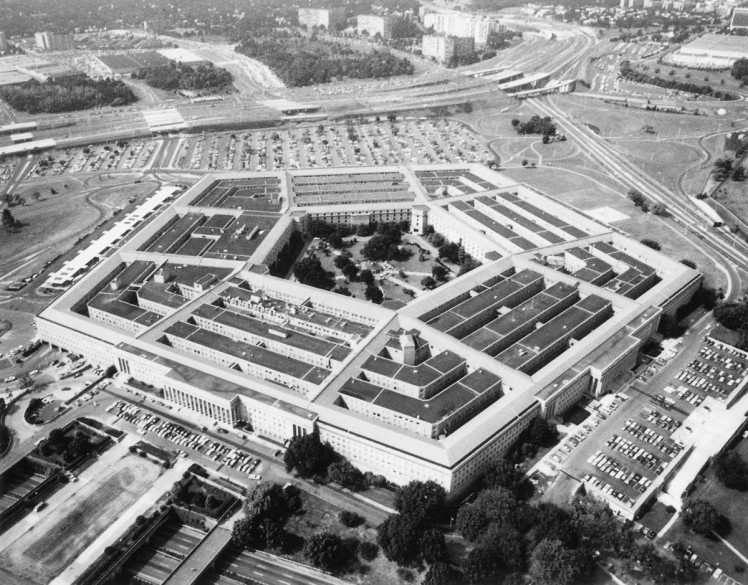
US Pentagon (C.1945)-Public Domain
Nineteen Forty-Five was a particularly turbulent year in American History. Not only was it the end of the largest and most costly war in history, but it also marked the beginning of a series of events destined to impact and change the US Military stratagem, and the course of the Navy’s role in national defense forever.
Technological gains in aviation were making it hard for the US Navy to justify the funding of a large Battleship-centrist fleet, especially in light of the dropping of the atomic bomb by the Army Air Corps late in the war.
Furthermore: the discussions between the War Department and the Department of the Navy on the concept of military unification begun by President Franklin Delano Roosevelt, a staunch Navy supporter, under the War Powers Act of 1941, and propagated by his successor President Harry Truman, a stubborn Army advocate, were turning problematic for the naval services.
In the face of demobilization, drastic fleet reductions and reorganization, logistic stresses, and reduced manning tables, and with the military unification discussions leaning heavily in favor of the Army, the Navy faced the possibility of not only becoming inadequate but marginalized relative to any future national defense strategies.
In addition, the Marine Corps, which had been faced with outright elimination several times in its history, was once again confronted with the possibility of total redundancy if not liquidation simply because of the precepts of what would turn out to be a false security created by atomic weapons.
To Secretary of the Navy James Forrestal’s chagrin, the influence of the Navy in government spheres was waning at a time when it could ill afford it. Its recent hegemony was being threatened as the old political biases and rivalries between the Army and Navy were once again poking their heads causing animosity and vitriol between the branches.
“Simultaneously with the Atomic Bomb as a weapon of immense strategic power the new age of American influence was threatened internally by the imbalance of equity between the branches of service over air power especially as it pertained to strategic air power and that of the bomb specifically.” – James Forrestal Diaries
This perceived loss of prominence, and shift in influence from the Navy in favor of the Army, and the additional competition for succor by the National Military Establishment, and the Navy’s need to retain an independent tactical if not strategic air force is what I believe to be the reason behind any Flight-19 conspiracy. The National Security Act of 1947 established a reorganization and reallocation of resources that was seen by many in the naval chain of command as a shift in the roles and missions of both the Navy and Marine Corps.
Contextually speaking, any loss of prestige by the Navy especially any failures specifically revolving around naval aviation, meant that it would not only be bargaining from a weaker political position in military unification talks such as those at the Key West Agreements of 1948, but in late 1945 the mere suggestion of an inept naval air training system must have been seen by the navy as another reason, another threat, to the argument for a carrier based fleet.
Unfortunately, only weeks before December 5th, the Navy had found itself forced to deal with the tragic loss of the USS Indianapolis on July 30th, 1945. The resulting court-martial of its captain, demanded by Admiral Ernest J. King, Chief of Naval Operations aided in damaging its reputation in the eyes of not only the public but perhaps more importantly, in Congress.
Furthermore, downplayed by V-J Day and once again the dropping of the atomic bomb the terrible loss of life was evidently and perhaps with concealment in mind moved to the back or bottom page of the newspapers almost obscuring it from the public eye.
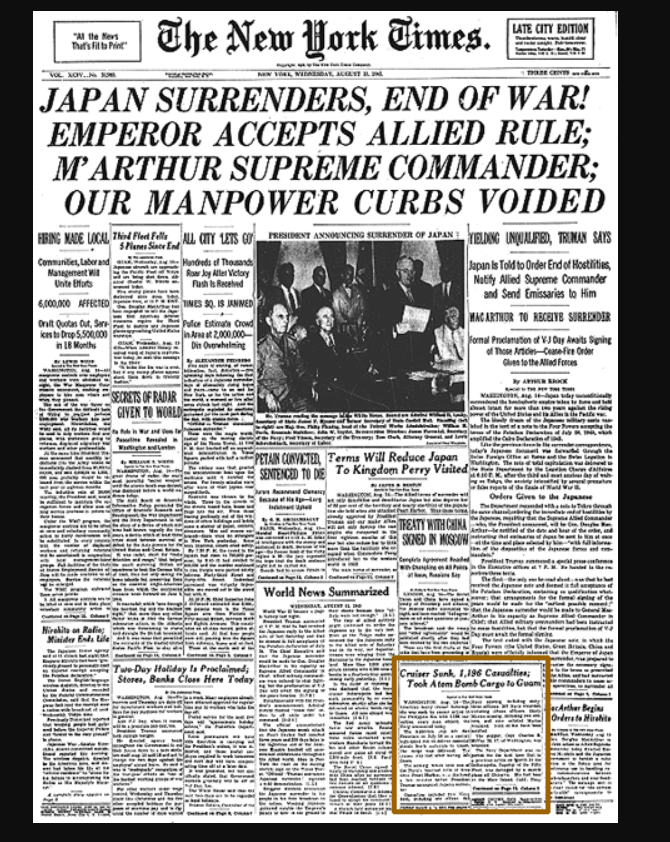
CONDUCT UNBECOMING
What was naturally considered by many a monumental failure of command by the ship Captain – a concept perpetuated by naval traditions and lore – leading to the death of hundreds of sailors and marines in the sinking of the ‘Indy‘, turned out to not only be a case of scapegoating of the captain, but a smokescreen of the larger issue of incompetant and possibly criminal negligence of the navy as a whole, or at least in the Pacific Theater of operations.
Then to have six training aircraft inexplicably go missing off the coast of Florida, on December 5th overlapping the tail end of the scandalous and nationally captivating court martial of Captain Charles B. McVay III (December 3rd-19th. 1945), must have certainly been disconcerting to the naval chain of command, to say the least.
Not to mention, the curious timing and speed of the first naval investigation of the Flight-19 disappearance, just five days into the search and rescue operations, and its conclusion on the 3rd of January 1946 suggests a possible malfeasance of its own.
BOARD VS COURT OF INQUIRY
It took weeks if not months for the board of investigation and court-martial of Captain McVay but only days for the board of inquiry into Flight-19. Why? Though the circumstances and scale of cases and the scope of the loss of life were much different, one case having actual survivors that could be questioned and the other not, the comparison of the two cannot be overlooked.
The question is if it had the desire to do so, and in the case of Flight-19, it seems it might had, what could the Navy do to mitigate the potential impact of another such deleterious investigation? Was the Official Flight-19 report buried on purpose or just lost within the myriad of paperwork that would naturally be associated with a large government organization?
With the newspaper headlines boldly announcing the additional disappearance of one of the PBM-5 Martin Mariners sent out as search and rescue of Flight-19, – just fanning the flames of the fire – is it unreasonable or unfair to assume that those in charge would not want to mitigate any further damage to naval stature, especially in the aviation community and if so create a willfull blindness feigning legitimate inquiry?
Either way, poor weather and faltering wills allowed leadership within the Naval Air Training Command as well as the 7th and, 8th Naval Districts, the Gulf and Eastern Sea Frontiers to take action curtailing a very expansive five-day search for survivors to be followed by a quick non-publicized investigation and rush to judgment against Lt. Charles C.Taylor, the flight leader.

In 1945 the FAA, National Transportation Safety Board (NTSB), and Naval Investigative Services (NIS) were in their infancy. The Navy Inspector General’s Office (IG) was only a few years old and the Naval Judge Advocate General (JAG) had just recently been given a large enough presence to be made effective as an office.
Before the UCMJ, (Uniformed Code of Military Justice) came into being the “Law of the Sea”, known as Rocks and Shoals stood as president to naval law. See the Caine Mutiny for an example of the ship-board legal system.
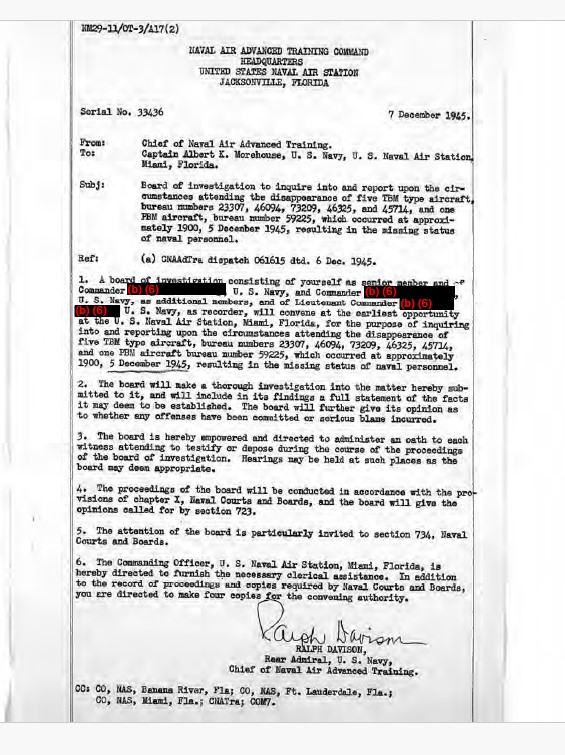
The four-man board convened by Navy Captain Albert K. Morehouse, Commanding Officer of NAS, Miami (Opa Locka), included Lieutenant Commander Richard S. (Robbie) Roberts, Operations Officer at NAS, Ft. Lauderdale, the board recorder, Commander
Joseph T. Yavorsky and Commander Howard S. Roberts both pilots, were directed to their task by Admiral Ralph E. Davison Advanced Naval Air Aviation Training Command Jacksonville, Florida, just two days into the Search and Rescue efforts.
It might be interesting for the reader to note that the investigation coincidentally occurred just before the holidays, and collectively at a time just before prominent naval line officer’s retirements or promotions?
Admirals Earnest King and William D Leahy for example were at the end of their tenure and about ready to retire from the active navy and Secretary James Forrestal and Admiral Chester Nimitz along with Admiral John H.Towers a prominent naval aviator and friend of Forrestals’, were being considered for advancements into key positions that would seemingly benefit the Navy after unification.
Just how critical then was it for the Navy to present a united front and prevent the case being made by Secretary Forrestal of the need for naval aviation amid the military unification talks from being scuttled?
In Jon Myhre’s book The Discovery of Flight-19 Lieutenant Commander Richard Roberts, claimed that he personally experienced and felt the pressure and tension being placed on the board members from the admiralty, mainly by NAS Jacksonville & NAS Pensacola for the proceedings to commence and conclude quickly. No doubt, it makes sense that Admirals Wagner & Davison recognized the significance of the proceedings and they too were feeling anxiety from the pressure above.
NAVAL CHAIN OF COMMAND AT THE END OF 1945 INTO 1946
SECRETARY OF THE NAVY – JAMES FORRESTAL
- Chief of Naval Operations (CNO) Ernest J. King (Aviator) – CNO Chester Nimitz
- Vice Chief of Naval Operations (VCNO) Admiral Richard Stanislaus Edwards
- Deputy Chief of Naval Operations for (Air), (DCNO)Marc Andrew Mitscher – Vice Adm. Arthur W. Radford,
- Chief of Naval Air Training, (CNAT) – Admiral Frank.D.Wagner
- Chief of Advanced Naval Air Aviation Training Command (ANAATC) Admiral Ralph E. Davison
But was the pressure so great that demonstrative and documentary evidence of several discrepancies within testimonies, some major contradictions and conflicts within the report including scrivener errors within the exhibits themselves indicates that the mishap was a case of human error, a confluence of incomplete and unverified aircraft maintenance, the weather, and faulty leadership decisions within the training system at NAS Ft. Lauderdale and the naval aviation training command itself were accidentally or even purposely overlooked?
According to Gian Quasar in his book, They Flew into Oblivion, and in my own research, one can’t help wondering why these errors were not noted and corrected or at least commented on by other reviewing agencies. They should have easily been caught had the board members or anyone reviewing the report done their due diligence. 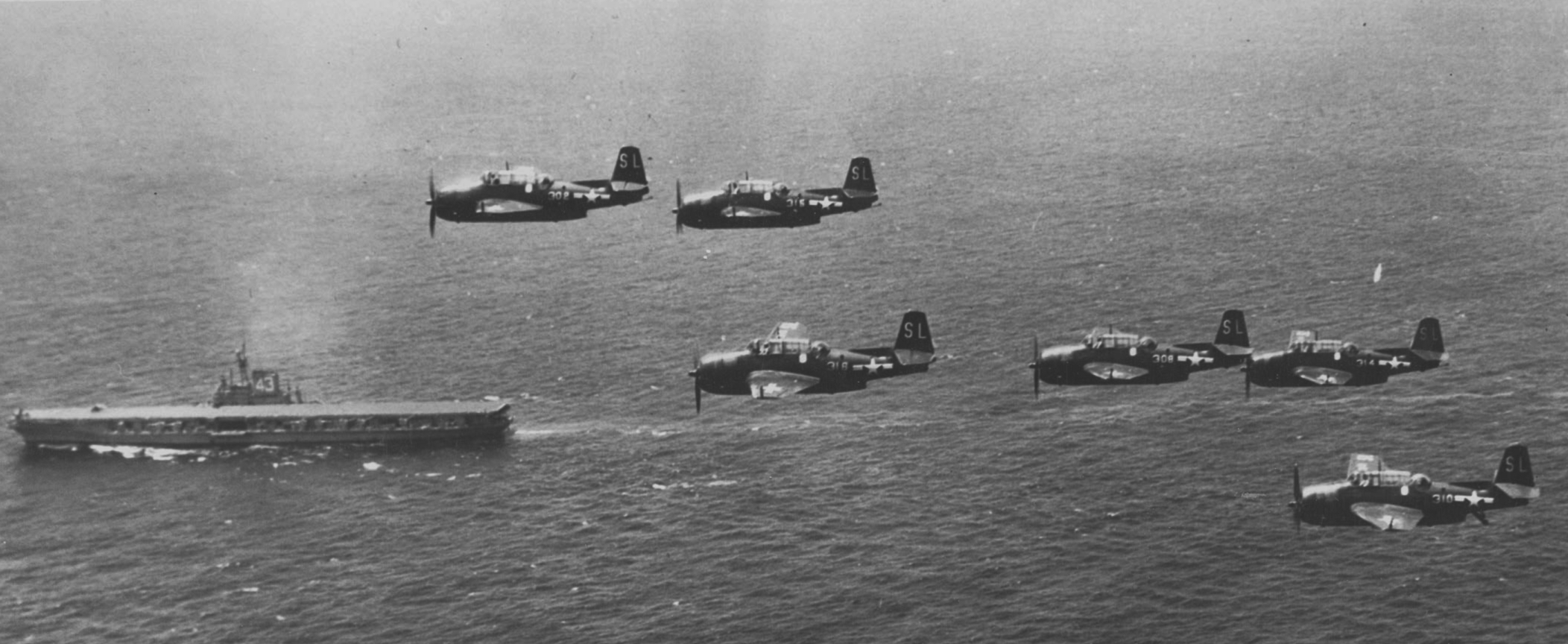
Three Divisions (or a flight) of TBF/M’s fly by the USS Coral Sea (US Navy)
It’s almost unimaginable what the outcome of a court-martial of the Flight-19 trainer/evaluator, Lt. Charles C. Taylor would have been if the planes and crews of the ill-fated flight had survived. Two Navy and three Marine Corps aircraft and crews were lost that day, lost during what may be considered an esoteric fact; that it was not just a training exercise, but a blind navigation test! Furthermore: The Training-49 crew (Combat Air Crew 88G) the PBM-5 Martin Mariner that was one of the two search planes sent to search for the missing TBM’s were also mostly all trainees!
THE BOARD OF CORRECTIONS
Admittedly speculative but not unreasonable, based on the outcome of the McVay Court Martial, and the results of the Official Board of Investigation into the Flight-19 disappearance the charges of dereliction of duty and insubordination at minimum would likely have been considered by the members leading to some form of a trial of Lt. Taylor and perhaps others if they had survived.
And yet though there was no opportunity to do so, that is in essence what happened, as the navy in the initial investigation assailed his stature in absentia, without him being able to defend himself, and with no conclusive evidence other than records of radio transmissions and interviews of ground personnel who were responsible for different aspects of the flight before it got off the ground.
But like Captain McVay, simply because he was in charge Lt. Taylor became the patsy for the combined errors of the entire Naval air training command that day.
“The Navy has a unique tradition: to hold accountable the highest levels of leadership for any event that causes harm to sailors or U.S. national security. While McVay’s conviction was legally correct, the standard of accountability applied to him was never applied with the same rigor to anyone else, and was not, therefore, a “standard.” – US Navy Institute.
In…Opinion #44 - read as such the loss of aircraft based on the state of mind of Lt. Taylor resulting from “Temporary Confusion…faulty judgment…..” and “That no offenses have been known to be committed …other than that which may be assigned….to Lt . Charles C. Taylor.”….etc. It’s only correct that he holds some form of culpability and in the end, Admiral Davison does mildly indicate other extenuating systemic factors for Taylor’s failure but only as a means to prevent future loss through training changes.
If not for the courage and fortitude of his Mother and Aunt to clear his name, a battle engaged with Rear Admiral Ralph E. Jennings, a highly respected Naval Aviator & his aide Captain Ben Scott Custer a second investigation between 1946 and 1947 by the Navy’s Board of Corrections exonerating Taylor altogether would not have occurred.
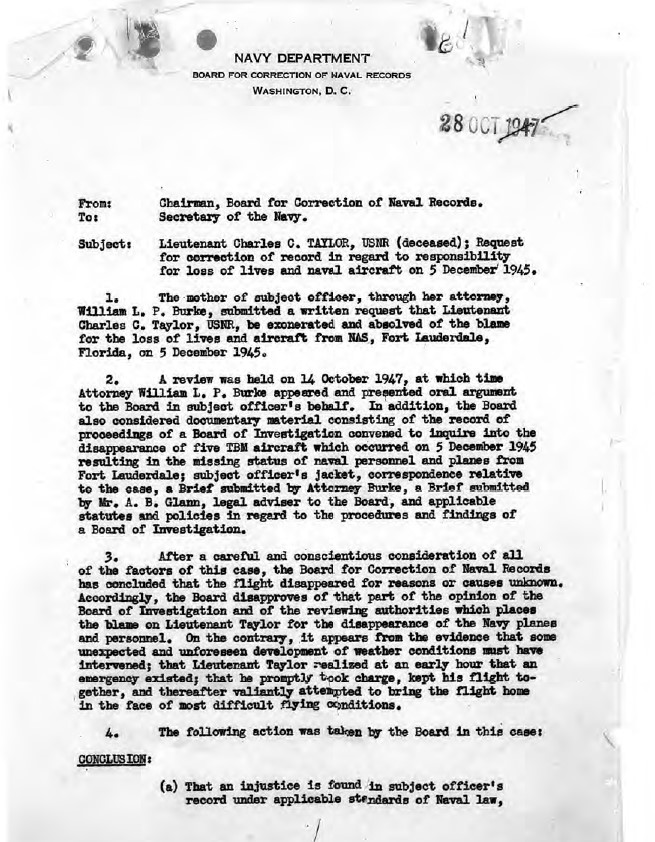

THE THIRD INVESTIGATION or REVIEW OF THE FIRST?
If it hadn’t been for the dauntless efforts of these two women, and the initial spur to action among relatives of the crews and politicians such as Senator David I Walsh (D) of Massachusetts, Chairman of the Naval Affairs Committee, Congressman Milton West, (D) Texas 15th District, William Sterling Cole 37th-39th District NY (R) the story of Flight-19 might not have seen the light of day.
A possible third Investigation or perhaps a review of the first report, putatively mounted by a surely ‘ole Marine Corps general, a former Marine aviator turned Congressman Melvin J. Maas Major General USMCR/and chief investigator for the House Naval Affairs Committee in 1945/46 said to have been prompted by a petition of 54 relatives of twelve of the missing men was asked of Secretary Forrestal to provide a congressional report. However, I have yet to find evidence of such an investigation.
In the background of both of these investigations, Secretary of the Navy Forrestal was desperately seeking parity with two opposing viewpoints within the Navy itself, those for and those against military unification. He also had to deal with an almost belligerent Admiral King, and simultaneously placate the Army as well as President Truman. All the while simultaneously lobbying for the strategic and tactical authority of naval aviation and the need for both in future unification plans and national defense was very burdensome. Now add the last apple to the apple cart. Flight-19.
NATIONAL SECURITY
So one may ask, how the Navy would even begin to create a willful blindness of the events of December 5th?
Though it was 1945 and the war was over, much of the equipment being used in the TBF/M Avenger was top-of-the-line. Operational security had been a sore spot in transferring equipment over to our allies even during the war. Items such as the Norden bombsight and direction-finding and radio equipment made aircraft such as the TBM-1E (FT-36 ) itself having an updated electronic suite, the TBM-3(D?) (FT-28) had a special form of radar attached to its wing specifically for anti-submarine patrolling. Operational security prevented the use of this equipment, by anyone not cleared to.
According to Presidential Executive Order 8381, certain vital military and naval installations and equipment dated 1940, as it pertains in regards to the National Security Classification Act from January 12th, 1938 just about every operational, technical, maintenance, part, and training manual, every memo, report, and communication could be potentially classified as Restricted or Confidential if it was determined by someone with the authority to have any information that could be used by an adversary against the US.
This capability gave the War Department (US Army) and the Department of the Navy, a wide latitude in defining what constitutes a threat to national security.
Because of National Security, the Official Flight-19 Naval Proceedings report of 1946 was at least in part classified as RESTRICTED and, was placed in cabinets, vaults, and archives throughout the Navy Department until it was moved along with other declassified documents sometime in the 1970’s and given to the National Archives, long after the National Security Act of 1947.
Today Flight-19 is still a sore spot on the Navy’s reputation and there is still rancor among the military establishment over unification. It is very likely that the risk of opening old wounds, the drain on money and time, potential lawsuits over jurisdictional differences as well as privacy concerns especially as it pertains to something as undefinable and embarrassing as losing aircraft in “the Bermuda Triangle” are what keep the Navy from willfully pursuing this issue any further. Though it cannot be conclusively proven at this time, the Navy likely buried the paperwork hoping it would never see the light of day again.
_______________________________________________________________________
- Admiral John H. Towers the struggle for naval air supremacy by Clark G. Reynolds NIP 1991
- The Disappearance of Flight-19, by Larry Kusche Harpercollins; 1980 ISBN 978-0-0601-2477-9
- The Discovery of Flight-19: A 30 year search for the lost patrol in the Bermuda Triangle, by Jon F. Myhre, 2012 Paragon Agency Publishers Orange CA
- The Forrestal Diaries Edited by Walter Millis with the Collaboration of E S Duffield, The Viking Press, New York October 1951, Copyright New York Herald Tribune 1951.
- Indianapolis by Lynn Vincent and Sara Vladic, Simon & Schuster NY 2018, ISBN 978-1-5011-3594-1
- In Harms Way: The Sinking of the USS Indianapolis and the Extraordinary Story of Its Survivors by Doug Stanton, Henry Holt and Company; 2001 ISBN 978-1-5673-1797-8
- NARA microfilm project # 1657, roll#1. Specifically dated 12 March 2001, 2461-0598-013-01 reduction # 10/16 processed by Sieh Loreta. (Berkshire Athenaeum) Pittsfield MA.
- Nimitz, Naval Institute Press, Annapolis, Maryland. E.B. Potter 1976, ISBN 0-8702-1492-6
- They Flew Into Oblivion: The Disappearance of Flight-19 by Gian J. Quasar 978-0-9888-5050-7 2013 Brodwyn-Moor & Doane
